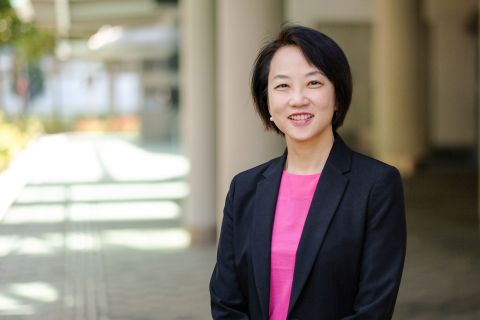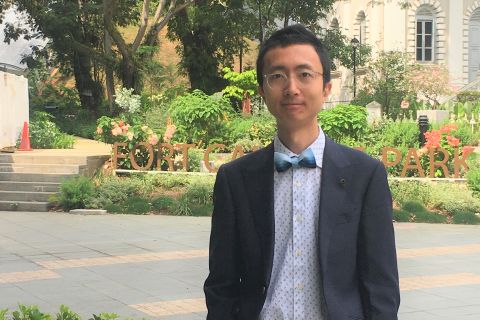
By Alvin Lee
SMU Office of Research & Tech Transfer – Since Kickstarter launched in April 2009, some US$4.6 billion have been pledged to fund over 170,000 projects. From one-time touted “Apple Killer” Pebble Time to Baubax, “The World’s Best Travel Jacket”, many commercial successes had their beginnings on the crowdfunding platform.
What these projects had in common, other than massive backing from the online crowd, was the use of product video. As pointed out by Kickstarter itself, “Kickstarter projects aren’t required to have videos, but we highly recommend it”. Writing at the end of 2009, Kickstarter pointed out that “projects with videos have had a success rate of 54% while the ones without have had a success rate of 39%”.
Fast forward to 2019, one SMU academic has found a new way to increase a project’s appeal: Having more ‘voices’ in the product video.
“We found that when you have multiple people conveying the product information, that leads to more funding,” explains Hannah Chang, Associate Professor of Marketing at the Lee Kong Chian School of Business (LKCSB). Leveraging recent advances in data analytics and machine learning methods, Professor Chang looked at data from all projects since the inception of Kickstarter in 2009 to 2017 and found that the phenomenon occurred across all product categories on offer.
In Crowdfunding: More voices, more money
Delving deeper into those findings, Professor Chang conducted experiments where she took Kickstarter videos pitching product innovations and removed the audio tracks. She then created videos with different versions, some with one voice and others with multiple voices.
Research participants were recruited and asked to fund a given project. The result: videos with multiple voices got more funding if participants are able to understand the innovation.
“We call it a Voice Numerosity Effect,” Professor Chang tells the Office of Research and Tech Transfer. “We found that usually when there's a change of voice conveying a message, people unknowingly start to pay more attention. It's not a very conscious process.” She adds:
“We also found that the effect is more pronounced when the information provided is simpler to understand. If we're talking about most of the innovations we see in the market every year, most of them are continuous or incremental innovations. That’s when the information is easier for people to process, and the [voice numerosity] effect emerges.”
Conversely, when launching products that are significantly different from those currently on the market, such as disruptive innovations, a single voice works better. Professor Chang notes that current practice focuses on the need for “a clear voice that signals authority and professionalism”, but has overlooked the importance of the number of voices involved.
Pointing to Apple’s recent product launches, Professor Chang illustrates how even big brands might not have fully understood and applied such knowledge. For the iPhone 11, which is an evolutionary mobile phone, the introductory video features only one voice – that of Dan Riccio, SVP of Hardware Engineering. But for the new Mac Pro computer system, which was built ground-up to address complaints over the 2013 version, there were two: Riccio’s and that of Jony Ive, Apple’s legendary and soon-to-be ex-Chief Design Officer.
The Experience Economy
Apple’s products are popular gifts for the end-of-year shopping season, budgets permitting. While the tech giant’s product quality and clever branding are key to its success, these are merely parts – albeit important ones – that make up the unique Apple experience. They are also part of Professor Chang’s latest research project: what consumers want in Singapore’s experience economy.
“The experience economy tends to be built on experiential products or services,” Professor Chang elaborates. “These are the kind of goods that people consume mainly for the experience, the feelings that you get. If you want to offer an experience to consumers, you need to understand what they want.
“How and when do people rely on their feelings? When do people engage in experiential consumption? Holiday shopping season tends to be the time where emotions matter. Whenever we go shopping, you hear the Christmas jingle, it reminds you, ‘Oh yes! This is the holiday season again.
“So this is a time that's excellent for brands and businesses to build deeper connections and customer relationships through superior consumer experiences. Emotions is something that's very effective in making and building stronger customer relationships.”
She concludes: “We have tons of data now. We know so much about consumers but there's a bottleneck in terms of how we can efficiently and effectively parse this information or data we have about consumers to help advise our marketing decisions.”
With a little help from the community
Professor Chang’s project on the experience economy secured her second Academic Research Fund (AcRF) Tier 2 Grant in two years from Singapore’s Ministry of Education (MOE). She secured her first Tier 2 grant last year for her Crowdfunding project.
As Principal Investigator (PI) on both projects, Professor Chang shares credit with her co-authors, Professors Anirban Mukherjee, Michelle Lee, Heli Wang, Chiying Cheng, and others for “carefully and repeatedly” discussing research ideas. Even though she had previously secured smaller Tier 1 grants from the MOE as PI, the SMU Excellent Teacher Award finalist lauds the University for invaluable feedback and support in navigating the Tier 2 grant application process.
“[These two projects] were the first times I have applied as a PI for a large, highly competitive external grant, so there are a lot of details that I wasn’t familiar with,” she recounts while pointing to a grant application workshop put together by ORTT. “The workshop was helpful in familiarising me with the grant application process. Importantly, the ORTT team gave me very constructive feedback and excellent, detailed comments in terms of how I can improve my application. These comments also helped refine my conceptualisation and thinking for the research.”
Besides guidance on procedural matters, Professor Chang also received feedback to write with a non-academic audience in mind.
“As academics, we tend to write to other academics who are in exactly our field, who are already experts,” she muses, articulating a common issue in grant applications. “It's only when I started writing the grant application that I realised, ‘Oh, the audience is very different. How do you convey your idea to a more general audience who are experts but not necessarily from your research area?’ Sometimes when I'm using technical language without realising it, they'll point it out.
“It's hard for me to pinpoint any one specific example, as they’ve provided so many excellent, helpful suggestions. There are a lot of details and thought to every grant application, and it definitely helps knowing that someone's got your back.”
Back to Research@SMU Nov 2019 Issue
See More News
Want to see more of SMU Research?
Sign up for Research@SMU e-newslettter to know more about our research and research-related events!
If you would like to remove yourself from all our mailing list, please visit https://eservices.smu.edu.sg/internet/DNC/Default.aspx

